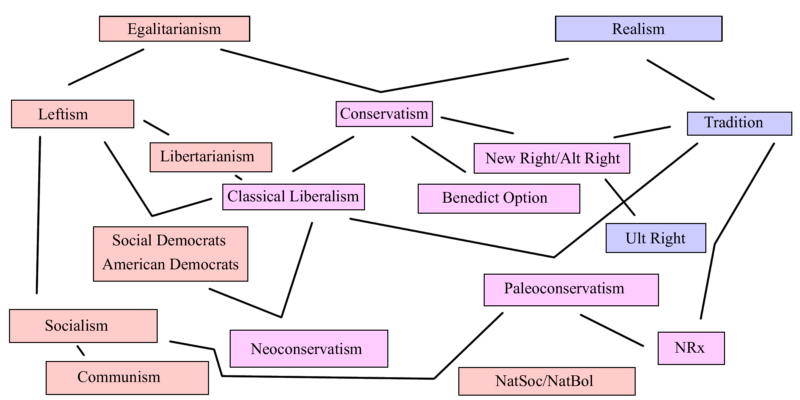A Political Chart That Reflects Politics As Philosophy
Some of these political charts have been floating around of late, so it seemed the right time to make one and to do so by treating politics as a series of philosophies, instead of as politics itself. That is, we focus on motivation and concept of the world instead of methods.
You will see two primary columns, “egalitarianism” and “realism.” This reflects the historical record of how Leftism arose as a competition to the way things had been done, and so soon presented two options, egalitarianism — this is the sole idea and core of Leftism — and the past methods, which had been adopted by evolutionary necessity.
Egalitarianism is an ideology that states that, to avoid conflict, we should make people equal, in contrast to how they are, “progressing” from a bloody and unequal primal state of nature to an enlightened™ Utopia where everyone is equal.
Ideology is a determination of how the world should work in contrast to how it does work; realism, on the other hand, is concerned with adapting and evolving in light of how reality does work. Egalitarianism recognizes that it is not based on what works, but what its proponents wish were true. It is conjecture and reality-independent theory.
Egalitarianism rewards individualism because it says, in effect, the individual cannot be constrained by predictions based in reality, such as the needs of civilization. Instead, “man is the measure of all things.”
This rapidly devolves to utilitarianism, or the idea that the greatest good is the happiness of the greatest number of people, a measurement which invariably consists of wants or desires instead of proven working solutions, which are naturally taken for granted and forgotten in most happiness calculations.
From egalitarianism comes the core of Leftism, which is the idea that egalitarianism can be implemented via politics as opposed to, for example, eugenics, in breeding people who are actually closer to “equal” in abilities, temperament, intellect, moral character, and inclination.
Conservatives, or those who sat on the Right in the post-Revolutionary General Assembly, are those who accept the fall of le ancien régime and its roots in classical culture and social order. For this reason, they have aspects of the egalitarian within them because they are committed to working within an egalitarian system.
The other column, “realism,” includes tradition as its primary member because tradition, like any behavior of a natural species, reflects what has worked over time and diverse circumstances. This comprises a set of principles and institutions more than anything else, but also a way of viewing the world as a type of abstract pattern language based in nature, into which humanity fits itself with its own hierarchy mirroring that of nature, and the goal of the individual is to adapt to these patterns and those of nature.
Conservatism rapidly splits into classical liberalism, or the idea that as long as property rights are preserved, the healthy vestiges of the past may endure. This went away for the most part once Leftist governments found that they could tax aristocrats and later the wealthy into oblivion.
Re-hybridized with Leftism, classical liberalism because libertarianism, or the notion that free markets within the context of modern society and a pseudo-anarchic outlook can provide the best outcome. To some degree, this preserves natural selection through Social Darwinism but this may not be enough.
When classical liberalism is re-infused with traditional thought, paleoconservatism — which demands preservation of institutions outside of government as well — emerges, avoiding the ideological nature of libertarianism and the classic “one size fits all” idea of the egalitarian ideologue within it.
However, the New Right and Alt Right, which occupy roughly the same sphere, correct this further by recognizing the esoteric nature of tradition. Freedom, given to a mob, results in more mob; freedom, given to the right people, results in them creating a hierarchy to restrict the masses and move society upward as natural selection once did.
Rising from the intersection of the Alt Right, Neoreaction, and tradition, the Ult Right goes further than the socialist-infused European New Right does, and slightly farther than the cultural wave movement of the Alt Right does; the Alt Right is probably a gateway to the Ult Right.
On the far Left, we can see the spectrum from Leftism, which prescribes egalitarianism, to socialism, which subsidizes it, and Communism, which enforces it through authoritarian means. When hybridized with paleoconservatism, these give rise to ideologies like National Socialism and National Bolshevism.
Hopefully this guide will clarify the philosophical differences between the different branches of politics and the resulting hybrids as people try to find a way to make the modern society model — the State and masses — functional, although that is in vain.
Tags: alt-right, classical liberalism, communism, democrats, national bolshevism, national socialism, neoreaction, new right, paleoconservatism, political chart, social democracy, socialism, tradition, traditionalism, ult right










